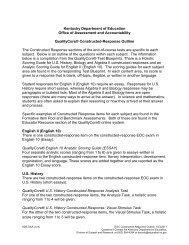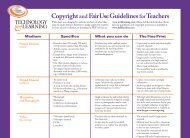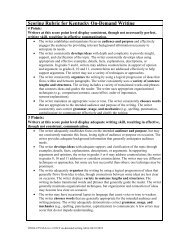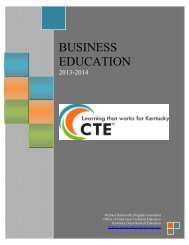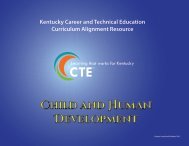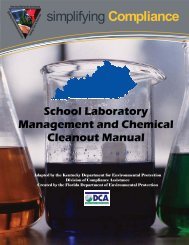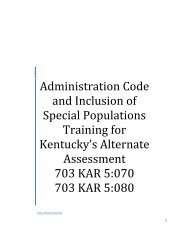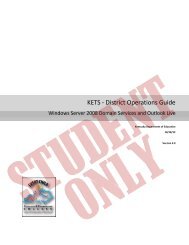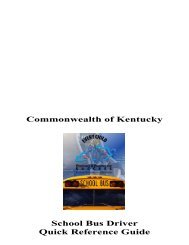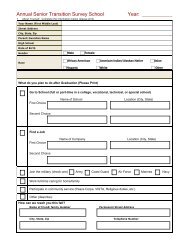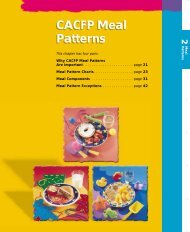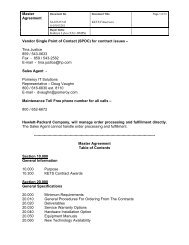Standards with Progressions grades K-HS v. 1.3 - Kentucky ...
Standards with Progressions grades K-HS v. 1.3 - Kentucky ...
Standards with Progressions grades K-HS v. 1.3 - Kentucky ...
- No tags were found...
You also want an ePaper? Increase the reach of your titles
YUMPU automatically turns print PDFs into web optimized ePapers that Google loves.
Fifth Grade Overview<br />
Domains<br />
Clusters<br />
Mathematical<br />
Practices<br />
Operations and<br />
Algebraic Thinking<br />
Write and<br />
interpret<br />
numerical<br />
expressions<br />
Analyze<br />
patterns and<br />
relationships<br />
1. Make sense of problems and<br />
persevere in solving them.<br />
Number & Operations<br />
in Base Ten<br />
Understand the<br />
place value system<br />
Perform operations<br />
<strong>with</strong> multi-digit<br />
whole numbers and<br />
<strong>with</strong> decimals to<br />
hundredths<br />
2. Reason abstractly and quantitatively.<br />
Number & Operations:<br />
Fractions<br />
Use equivalent fractions as a<br />
strategy to add and subtract<br />
fractions<br />
Apply and extend previous<br />
understandings of<br />
multiplication and division to<br />
multiply and divide fractions<br />
3. Construct viable arguments and<br />
critique the reasoning of others.<br />
4. Model <strong>with</strong> mathematics.<br />
Measurement and Data<br />
Convert like measurement units<br />
<strong>with</strong>in a given measurement system<br />
Represent and interpret data<br />
Geometric measurement:<br />
understand concepts of volume and<br />
relate volume to multiplication and<br />
to addition<br />
5. Use appropriate tools<br />
strategically.<br />
6. Attend to precision.<br />
Geometry<br />
Graph points on the<br />
coordinate plane to solve<br />
real-world and<br />
mathematical problems<br />
Classify two-dimensional<br />
figures into categories<br />
based on their properties<br />
7. Look for and make use of structure.<br />
8. Look for and express regularity in<br />
repeated reasoning.<br />
In Grade 5, instructional time should focus on three critical areas:<br />
1. Developing fluency <strong>with</strong> addition and subtraction of fractions, developing understanding of the multiplication of fractions and of division of fractions in limited<br />
cases (unit fractions divided by whole numbers and whole numbers divided by unit fractions)<br />
Students apply their understanding of fractions and fraction models to represent the addition and subtraction of fractions <strong>with</strong> unlike denominators as equivalent<br />
calculations <strong>with</strong> like denominators. They develop fluency in calculating sums and differences of fractions, and make reasonable estimates of them. Students also<br />
use the meaning of fractions, of multiplication and division, and the relationship between multiplication and division to understand and explain why the procedures<br />
for multiplying and dividing fractions make sense. (Note: this is limited to the case of dividing unit fractions by whole numbers and whole numbers by unit<br />
fractions.)<br />
2. Extending division to 2-digit divisors, integrating decimal fractions into the place value system and developing understanding of operations <strong>with</strong> decimals to<br />
hundredths, and developing fluency <strong>with</strong> whole number and decimal operation<br />
Students develop understanding of why division procedures work based on the meaning of base-ten numerals and properties of operations. They finalize fluency<br />
<strong>with</strong> multi-digit addition, subtraction, multiplication, and division. They apply their understandings of models for decimals, decimal notation, and properties of<br />
operations to add and subtract decimals to hundredths. They develop fluency in these computations, and make reasonable estimates of their results. Students use<br />
the relationship between decimals and fractions, as well as the relationship between finite decimals and whole numbers (i.e., a finite decimal multiplied by an<br />
appropriate power of 10 is a whole number), to understand and explain why the procedures for multiplying and dividing finite decimals make sense. They compute<br />
products and quotients of decimals to hundredths efficiently and accurately.<br />
3. Developing understanding of volume<br />
Students recognize volume as an attribute of three-dimensional space. They understand that volume can be quantified by finding the total number of same-size<br />
units of volume required to fill the space <strong>with</strong>out gaps or overlaps. They understand that a 1-unit by 1-unit by 1-unit cube is the standard unit for measuring<br />
volume. They select appropriate units, strategies, and tools for solving problems that involve estimating and measuring volume. They decompose threedimensional<br />
shapes and find volumes of right rectangular prisms by viewing them as decomposed into layers of arrays of cubes. They measure necessary<br />
attributes of shapes in order to solve real world and mathematical problems.<br />
<strong>Kentucky</strong> Department of Education<br />
29 | P a g e




